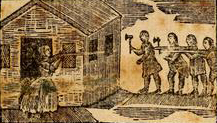John Black
Database: Great Migration Begins: Immigrants to New England, 1620-33
Migration: 1629 on Talbot
First Residence: Salem
Removes: Beverly
Occupation: Husbandman
Church Membership: In list of Salem church members before reorganization in late 1636 [SChR 6]; membership prior to 6 March 1631/2 implied by freemanship.
Freeman: 6 March 1631/2 [MBCR 1:367].
Education: Signed petition of 13 May 1640 [EQC 7:201].
Offices: Essex petit jury 27 December 1636 [EQC 1:4]
Estate: 1636, granted 30 acres at Jeffrey's Creek as a freeman of Salem [STR 1:20, 25, 26, 37]. 25 December 1637, granted three-quarters of an acre of marsh, based on a household of four persons [STR 1:102].
Joined petition of 13 May 1640, made by seventeen Salem men, for land at Jeffrey's Creek "to erect a village there" [MBCR 1:288-89; EQC 7:201-02].
On 28 October 1668 John Black Sr. of Salem, planter, sold to William Browne Jr. of Salem for £6 one acre salt marsh in North Field [ELR 3:52].
On 20 April 1670 John Black Sr. of Beverly, husbandman, sold to "my son John Black of the same" for £8 house lot & orchard in Beverly
except two acres of land out of the said lot, which I do give & set over unto my son-in-law Isaack Davis, they to pay rent to John Sr.
and two acres meadow in Topsfield [ELR 3:140].
Administration granted 20 July 1675 to John, son of John Black, intestate;
ordered to pay 50s. to each of his three sisters, Eliza Kemboll, Pearcis Follett and Lydia Davis.
The inventory, taken 12 April 1675 by Thomas Lathrop and John Hill, amounted to £1110s., and included no real estate [EPR 3:9; EQC 6:50].
Birth: About 1591 (at Salem Quarterly Court for 9 September1645, the court exempted from training "John Black being poor & aged 54" [EQC 1:84]; note that this would make Black 38 years old in 1629, when we first see him with a family).
Death: 16 March 1674/5 [EPR 3:9; EQC 6:50, from inventory].
Marriage: By 1629; about July 1646 the "wife of John Blak" gave evidence in court against the wife of Thomas Oliver of Salem [EQC 1:99].
Children:
i. Child, died aboard Talbot 24 June 1629 [Higginson 76].
ii. Elizabeth, born about 1631; married
(1) about1655 Humphrey Gilbert; married
(2) Ipswich 24 September 1658 William Raynor; married
(3) by 1675 Henry Kimball; married
(4) by 1679 Daniel Kilham;
Elizabeth was alive in 1686, and died before 29 March 1693 [TAG 17:135-36].
iii. Persis, born about 1633; married Salem 29 November 1655 Robert Follett.
iv. Lydia, baptized Salem 25 December 1636 [SChR 16]; died soon, probably before 25 December 1637.
v. Lydia, baptized Salem 3 June 1638 [SChR 16]; married Beverly 28 September 1659 Isaac Davis [GDMNH 183-84].
vi. Daughter, baptized Salem 27 November 1640 [SChR18]; died without issue before 20 July 1675.
vii. John, born about 1642 (deposed 15 September 1673 "aged about thirty-one years" [EQC 5:216]); m.
(1) Salem 29 July 1664 Freeborne Sallowes (widow of Robert Sallowes and daughter of Peter Woolfe), who d. Beverly 30 January 1681 aged about 46 ; m.
(2) by 1686 Deborah _____ (Elizabeth, daughter of John and Deborah Black, b. Beverly 31 May 1686); poss. m. (3) Beverly (int.) 18 August 1700 Mary Morgan.


